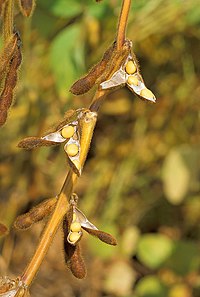
Photo from wikipedia
Summary Soybean cyst nematode (SCN) is the most devastating plant‐parasitic nematode. Most commercial soybean varieties with SCN resistance are derived from PI88788. Resistance derived from PI88788 is breaking down due… Click to show full abstract
Summary Soybean cyst nematode (SCN) is the most devastating plant‐parasitic nematode. Most commercial soybean varieties with SCN resistance are derived from PI88788. Resistance derived from PI88788 is breaking down due to narrow genetic background and SCN population shift. PI88788 requires mainly the rhg1‐b locus, while ‘Peking’ requires rhg1‐a and Rhg4 for SCN resistance. In the present study, whole genome re‐sequencing of 106 soybean lines was used to define the Rhg haplotypes and investigate their responses to the SCN HG‐Types. The analysis showed a comprehensive profile of SNPs and copy number variations (CNV) at these loci. CNV of rhg1 (GmSNAP18) only contributed towards resistance in lines derived from PI88788 and ‘Cloud’. At least 5.6 copies of the PI88788‐type rhg1 were required to confer SCN resistance, regardless of the Rhg4 (GmSHMT08) haplotype. However, when the GmSNAP18 copies dropped below 5.6, a ‘Peking’‐type GmSHMT08 haplotype was required to ensure SCN resistance. This points to a novel mechanism of epistasis between GmSNAP18 and GmSHMT08 involving minimum requirements for copy number. The presence of more Rhg4 copies confers resistance to multiple SCN races. Moreover, transcript abundance of the GmSHMT08 in root tissue correlates with more copies of the Rhg4 locus, reinforcing SCN resistance. Finally, haplotype analysis of the GmSHMT08 and GmSNAP18 promoters inferred additional levels of the resistance mechanism. This is the first report revealing the genetic basis of broad‐based resistance to SCN and providing new insight into epistasis, haplotype‐compatibility, CNV, promoter variation and its impact on broad‐based disease resistance in plants.
Journal Title: Plant Biotechnology Journal
Year Published: 2019
Link to full text (if available)
Share on Social Media: Sign Up to like & get
recommendations!